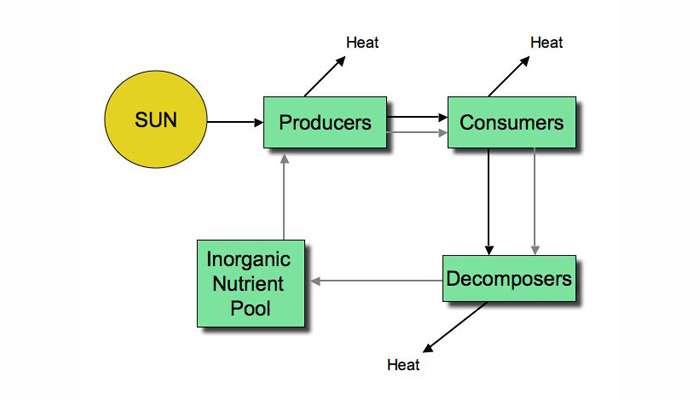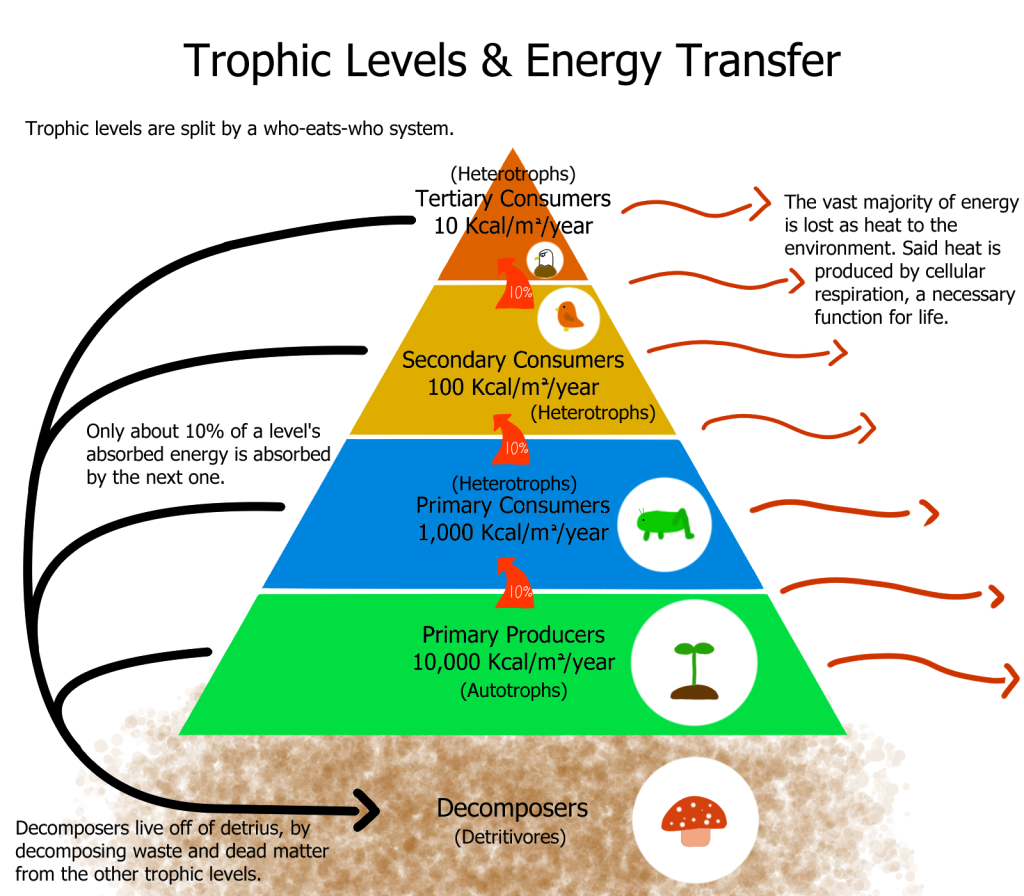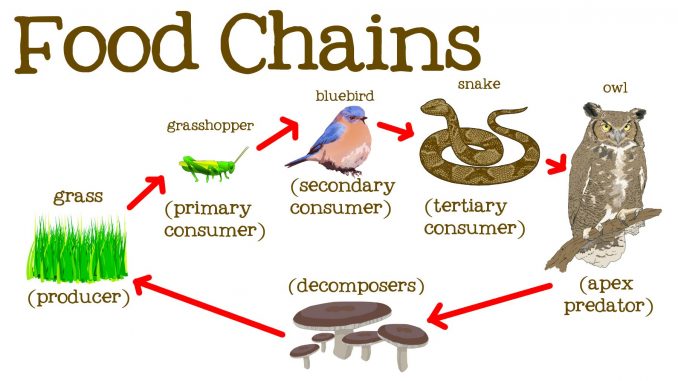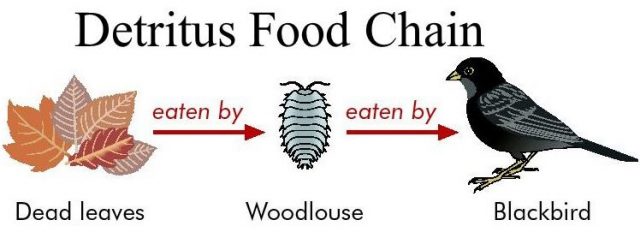Energy Flow Study Guide
Introduction:
The plants absorb as little as 1% of the emitted sunlight from the sun, convert it into a form of energy sufficient to power and support life on the earth. This occurs in a sequence of nutrient flow cycles amongst the living and nonliving components of the ecosystem. This guide helps to understand the energy flow in an ecosystem.
What is the Flow of Energy called?
The energy that enters an ecosystem is calculated in the form of calories or joules, and therefore the energy flow is called “calorific flow.”
Energy is the capacity to perform any work. Potential energy is the stored energy or the energy at rest capable of performing any work, and kinetic energy is the free energy in motion. Source
Source
Types of Energy Flow
-
Converting the radiant energy in the form of electromagnetic waves like sunlight into fixed potential energy is done by the plants.
-
Fixed potential energy, bound in many organic materials, is broken down to release the stored energy.
-
This occurs within the concept of the first law of thermodynamics, which states that energy can neither be created nor destroyed but only transformed from one form to another.
-
Organisms that fix radiant energy to produce organic matter are “autotrophs.”
-
Organisms that depend on energy-rich organic matter synthesized by the autographs are called “heterotrophs” or consumers since they obtain energy from other living organisms.
-
Decomposers are bacteria or fungi that obtain their energy from dead and decaying organisms.
-
The second law of thermodynamics explains the dissipation of heat energy into its surroundings during energy flow.
-
When it is emitted, sunlight or solar energy enters the earth’s atmosphere, is transformed into chemical energy, and stored in organic matter in plants.
-
When the herbivores feed on plants, they convert this chemical energy into kinetic energy.
-
Some energy is degraded during this process into heat energy and released.
-
Similarly, when carnivores feed on the herbivores and secondary carnivores feed on the primary carnivores, more energy will be degraded.
Stages of Energy Flow
- The producers and consumers are categorized into many feeding groups known as trophic levels.
- Producers or plants form the first trophic level.
- Herbivores consume the trapped energy in the plants for their energy, eaten by the carnivores. Hence food from the first trophic level is transferred into the second trophic level. This is called a food chain.
- Energy always flows in one direction within a food chain from solar energy to producers to herbivores to carnivores.
- The solar energy captured by the autographs does not go back to the sun, flows progressively, and is unavailable to the previous trophic levels once passed on.
There are three types of food chains within an ecosystem :
- The Grazing Food Chain starts with the green plants being consumed by the primary consumers (herbivores), who the secondary consumers consume (carnivores), who are in turn consumed by tertiary consumers( secondary carnivores), and so on.
The energy produced by the green plants is used in respiration, stored in the form of carbohydrates, proteins, and fats used by the herbivores for their survival, and is passed on to the carnivores, who have more complex molecules.
The decomposers convert the stored energy and release it into the environment upon their death.
-
The Parasitic Food Chain transfers energy from larger organisms to smaller ones without predation.
-
The Detritus Food Chain comprises detritus or dead organic matter such as metabolic wastes from the grazing food chain. The energy within the residue is a source of energy for detritivores such as bacteria, fungi, algae, actinomycetes, slime molds, etc. They decompose the organic matter, obtain chemical energy, and release the remaining into simple organic forms such as water.
The 10% law of Energy Transfer
Whenever energy is passed from one trophic level to the next within an ecosystem, only about ten percent of it is passed on. At the same time, the remaining are either broken down during respiration or digested and lost. This is also called ecological efficiency and was proposed by Raymond Lindeman in 1942.
Conclusion:
- The growth, reproduction, and survival of living organisms are dependant on the energy they obtain from the energy flow through an ecosystem.
- As the energy is passed on from one level to another, the quantity of available energy decreases.
- Still, there is stability due to the flow of energy in an ecosystem.
FAQs:
1. What is an example of energy flow?
Autotrophs absorbing solar energy and converting it into chemical energy for their survival is an example of energy flow.
2. What are the types of energy flow?
Radiant energy or solar energy and fixed energy, which living organisms can use, are the two types of energy flow.
3. How do you describe the flow of energy?
The transfer of energy from one organism to the next within a food chain, starting with the producers or plants to the herbivores who feed on producers and become the primary consumers to the carnivores who feed on the herbivores and thus transfer the stored energy from them for their survival is the process by which energy flows within an ecosystem.
4. How does energy flow work?
Energy is transferred from one trophic level to the organisms within the next trophic level in a food chain is how energy flows unidirectionally.
5. What is the importance of energy flow?
The energy flow within an ecosystem is important to maintain an ecological balance. For example, during photosynthesis, plants convert solar energy into chemical energy they need for their growth and survival while also storing it. The same plants are consumed by herbivores who consume the nutrients within plants to grow and survive.
6. Where does energy flow from?
Energy flows from the sun to the autotrophs who absorb, convert and store it within themselves. Primary consumers feed on autotrophs and take up their stored energy. Secondary consumers then eat the primary consumers, and thus the energy flows from one trophic level to the next.
7. What is an energy flow diagram?
It tracks how energy flows from one level to the next within an ecosystem, starting from the raw or primary energy source to the next transformed level and so on.
8. What is the ten percent law of energy?
It states that approximately only ten percent is transferred to the next stage during energy transfer within the various trophic levels while the remaining is lost.
9. What are the stages of energy flow?
The stages of energy transfer within an ecosystem are producers, primary consumers, secondary consumers, and tertiary consumers.
10. How does energy flow in the natural environment?
Photo autotrophs trap solar energy during photosynthesis in the form of chemical energy, which is taken up by the herbivores and later by the carnivores and the tertiary consumers. This is how energy flows within the natural environment.
We hope you enjoyed studying this lesson and learned something cool about the Energy Flow! Join our Discord community to get any questions you may have answered and to engage with other students just like you! Don’t forget to download our App and check out our awesome VR room for this guide – we promise it makes studying much more fun 😎
Sources:
- Energy Flow https://flexbooks.ck12.org/cbook/ck-12-biology-flexbook-2.0/section/6.2/primary/lesson/flow-of-energy-bio/ Accessed on 1 Dec 2021.
- Energy Flow in Ecosystem https://www.embibe.com/exams/energy-flow-in-ecosystem/ Accessed on 1 Dec 2021.
- Flow of Energy in Ecosystems https://www.ck12.org/c/earth-science/flow-of-energy-in-ecosystems/lesson/Flow-of-Energy-in-Ecosystems-HS-ES/ Accessed on 1 Dec 2021.



